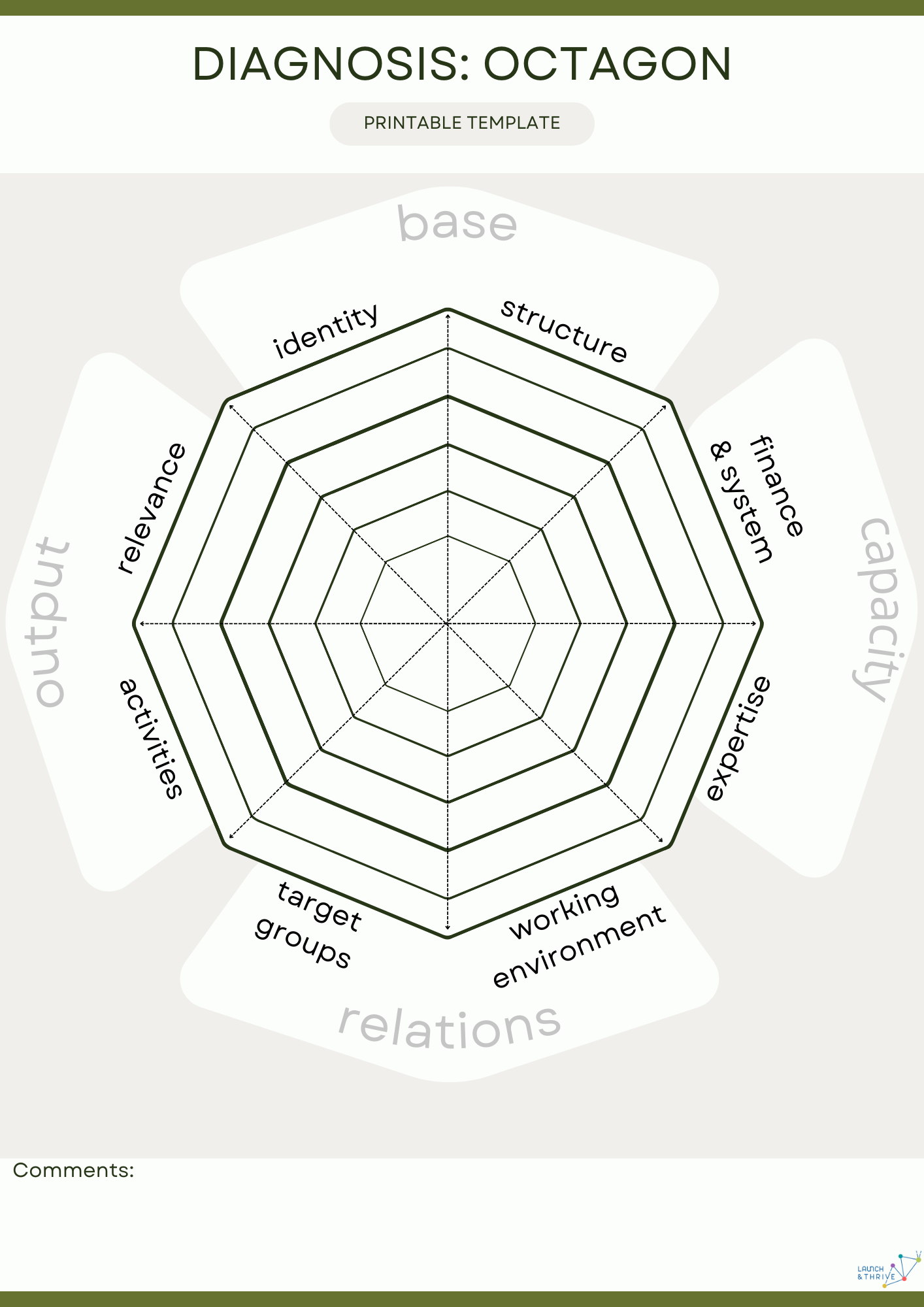∆ Tool: OCTAGON

DURATION: 30 min - 1 h
This tool can be used to analyse an organisation's development with eight different variables.
I. On the one hand, the octagon is a tool for the follow-up and measurement of results of organisation development.
It is important to be aware of the fact that the Octagon is based completely on subjective assessments of the organisation. Its subjectivity makes the Octagon a sensitive instrument. Therefore, it is important to give reasons in writing for each ranking of the Octagon’s eight variables on the very first occasion measurements are made. To measure results, it is necessary to make analyses of the same variable on several occasions over a long period, for example at one-year or five-year intervals. Since the person who makes the first Octagon analysis of a partner organisation may change his/her opinion over the course of time or maybe be replaced, it is necessary to document what, for example, was the reason for awarding four points in one part of the Octagon analysis on the first occasion. The weakness of the Octagon as an instrument for measuring change is the risk that it is the basis used for personal assessments that has changed and is reflected in the Octagon’s results, rather than real changes at the partner organisation. As long as there is awareness of this risk and everything possible is done to eliminate subjectivity in assessments, the Octagon will function as a tool for rapid results analyses.
II. On the other hand, this tool can be used to start organisation development at a deeper level.
If you, as a financier, partner or consultant, intend to use the Octagon for organisation development purposes, it is important to remember that the Octagon is a tool for making a rough initial analysis of an organisation. Thereafter, other tools must be used. The responsibility for the process must rest with the partner organisation. Never- theless, you must explain that the purpose of your initiative to make an Octagon analysis is the first stage in providing support for the internal organisational development of the partner organisation, and describe the forms of your support for this process in the future. Is your role to finance measures that have been identified? To act as a sounding board or as a mentor? Or something else?
How to use the Octagon
The Octagon is constructed in such a way that four basic aspects of the network are analyzed with the aid of eight variables.
The organization’s base:
1. Identity: The network expresses its basic values and has articulated the reasons for its existence.
2. Structure: The organization’s management and its division of duties and responsibilities are explicit and visible.
The organization’s activities – output:
3. Implementation of activities: The organization can plan and implement planned activities.
4. Relevance of activities: The content of activities and the methods used are relevant to the organization’s vision and operational objectives.
The organization’s capacity development:
5. Professional skills: voluntary and paid staff and management have the requisite professional skills and qualifications to pursue and develop the organization’s operational objectives and vision.
6. Systems: The organization has the financial resources and administrative routines to run its activities.
The organization’s relations:
7. Acceptance and support of target groups: The target groups’ assessment of the organisation and the demand for its activities give the organization legitimacy.
8. Relations with its external environment: The organization is accepted and supported in the community and can mobilize support for its vision and operational objectives.
The eight variables form an octagon. Each dimension is ranked by assessments of two statements/questions on a six-point scale. When all the variables have been analyzed and ranked, the organization’s development profile is illustrated in the form of an octagon.
GOOD TO KNOW: Be aware of the fact that the Octagon is based completely on subjective assessments of the organisation or network. Its subjectivity makes the Octagon a sensitive instrument. Therefore, it is important to give reasons in writing for each ranking of the Octagon’s eight variables on the very first occasion measurements are made.
To measure change, it is necessary to make analyses of the same variables on several occasions over a longer period, for example, 3 months, or one year.
The PDF and illustration below can help you assess your organisation's development.

